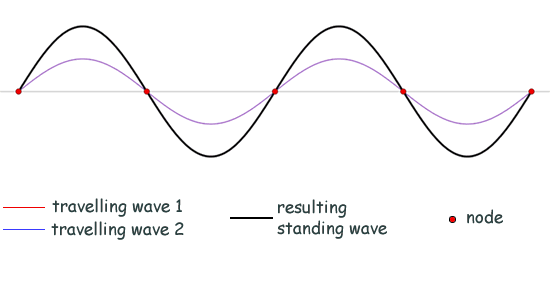Standing or Stationary Waves A standing wave or a stationary wave, is a wave that has fixed displacement for all points along its length.
Nodes - points of no displacement - remain in the same position. Particles at those points are not vibrating at all - they vibrate with zero displacement. Antinodes are points on the waveform where the particles suffer maximum displacement. Standing waves can occur when the medium is moving in the opposite direction to the wave (as in the surfing vidclip below), or it can arise in a stationary medium as a result of interference between two waves travelling in opposite directions (the usual source for a question at A level). In the second case, for waves of equal amplitude travelling in opposing directions, there is on average no net propagation of energy. The energy 'stands still' so it is a standing wave - or is stationary - another way of putting it! The best way to get two waves of equal frequency, wavelength and amplitude so that you get completely destructive interference at the nodes is to reflect a wave from a fixed point. The above vidclip is a demo of the standard classroom 'vibrating sting' - listen carefully to the teacher - she touches on a lot of information in this clip! Below is a wonderful vidclip of standing waves in water - couldn't do this easiliy in a school lab! The next vidclip is amazing - surfing on a standing wave... |
Follow me...
|






